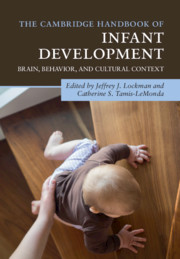Book contents
- The Cambridge Handbook of Infant Development
- The Cambridge Handbook of Infant Development
- Copyright page
- Dedication
- Contents
- Illustrations
- Contributors
- Preface
- Part I Foundations
- Part II Perceptual Development
- Part III Cognitive Development
- Part IV Action
- 17 Action in Development
- 18 The Mirror Neuron System and Social Cognition
- 19 Infant Object Manipulation and Play
- 20 The Infant’s Visual World
- Part V Language
- Part VI Emotional and Social Development
- Index
- References
20 - The Infant’s Visual World
The Everyday Statistics for Visual Learning
from Part IV - Action
Published online by Cambridge University Press: 26 September 2020
- The Cambridge Handbook of Infant Development
- The Cambridge Handbook of Infant Development
- Copyright page
- Dedication
- Contents
- Illustrations
- Contributors
- Preface
- Part I Foundations
- Part II Perceptual Development
- Part III Cognitive Development
- Part IV Action
- 17 Action in Development
- 18 The Mirror Neuron System and Social Cognition
- 19 Infant Object Manipulation and Play
- 20 The Infant’s Visual World
- Part V Language
- Part VI Emotional and Social Development
- Index
- References
Summary
The prowess of human vision is central to many domains of human intelligence (DiCarlo & Cox, 2007). We discriminate thousands of individual faces, recognize thousands of object categories, and excel under challenging visual conditions. We can become visual experts in recognizing birds, mathematical equations, art, and more. The developmental path to these achievements is protracted with mature levels of competence not fully reached until adolescence (Hadad, Maurer, & Lewis, 2011; Nishimura, Scherf, & Behrmann, 2009). The evidence also shows marked changes in infancy in the domains of face processing and object recognition. The evidence makes clear that visual experience itself is a significant driver of these changes (Maurer, Mondloch, & Lewis, 2007; Smith, 2009). A complete theory of learning in any domain requires an understanding of both the learning mechanisms and the experiences – the data – on which those mechanisms operate. Although much research is directed to determining the developing mechanisms, little has been directed to visual experience itself.
Keywords
- Type
- Chapter
- Information
- The Cambridge Handbook of Infant DevelopmentBrain, Behavior, and Cultural Context, pp. 549 - 576Publisher: Cambridge University PressPrint publication year: 2020



